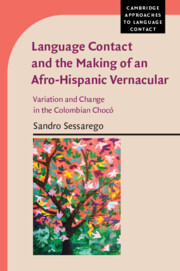 Language Contact and the Making of an Afro-Hispanic Vernacular
Language Contact and the Making of an Afro-Hispanic Vernacular Book contents
- Language Contact and the Making of an Afro-Hispanic Vernacular
- Cambridge Approaches to Language Contact
- Language Contact and the Making of an Afro-Hispanic Vernacular
- Copyright page
- Dedication
- Contents
- Figures
- Tables
- Maps
- Series Editor’s Foreword
- Acknowledgments
- 1 Introduction
- 2 The Place of Chocó Spanish in the Spanish Creole Debate
- 3 A Sketch of Chocó Spanish
- 4 Roots of Some Languages
- 5 Black Slavery in the Pacific Lowlands of Colombia
- 6 Testing the Legal Hypothesis of Creole Genesis on Colonial Chocó
- 7 Final Considerations
- Appendix
- References
- Index
1 - Introduction
Published online by Cambridge University Press: 23 August 2019
- Language Contact and the Making of an Afro-Hispanic Vernacular
- Cambridge Approaches to Language Contact
- Language Contact and the Making of an Afro-Hispanic Vernacular
- Copyright page
- Dedication
- Contents
- Figures
- Tables
- Maps
- Series Editor’s Foreword
- Acknowledgments
- 1 Introduction
- 2 The Place of Chocó Spanish in the Spanish Creole Debate
- 3 A Sketch of Chocó Spanish
- 4 Roots of Some Languages
- 5 Black Slavery in the Pacific Lowlands of Colombia
- 6 Testing the Legal Hypothesis of Creole Genesis on Colonial Chocó
- 7 Final Considerations
- Appendix
- References
- Index
Summary
Of all the Afro-Hispanic languages of the Americas (AHLAs), the one that more than any other has puzzled linguists interested in the origin and evolution of these contact varieties is definitively Chocó Spanish (CS) (McWhorter 2000; Lipski 2005). CS is the dialect spoken by the inhabitants of the Department of Chocó (Map 1.1), Colombia, a region where blacks represent more than 90 percent of today’s total population (DANE 2005) and consist of the descendants of the slaves taken to this region during colonial times to work the rich gold mines of the area.
- Type
- Chapter
- Information
- Language Contact and the Making of an Afro-Hispanic VernacularVariation and Change in the Colombian Chocó, pp. 1 - 6Publisher: Cambridge University PressPrint publication year: 2019
